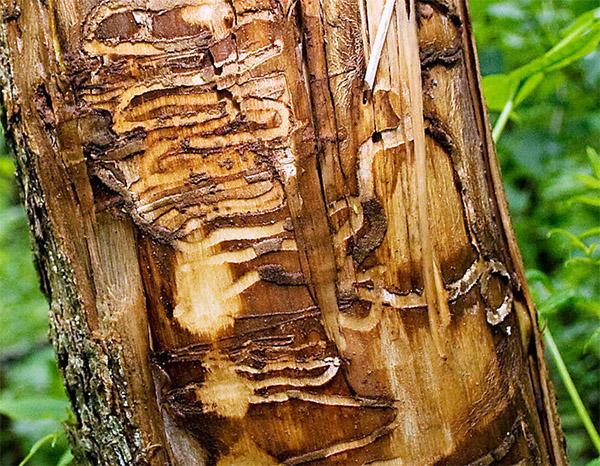Despite a name that some view as the butt of a joke (Randy Wilson, you know who you are), the emerald ash borer and the threat it poses to trees and forests throughout the country is no laughing matter.
 Although the EAB has no natural predators in North America, it is slowly moving across the country. Once a problem confined to parts of the upper Midwest and Mid Atlantic regions, this tiny invasive pest is causing big problems in ash trees across a range that now includes 30 states, including 10 west of the Mississippi.
Although the EAB has no natural predators in North America, it is slowly moving across the country. Once a problem confined to parts of the upper Midwest and Mid Atlantic regions, this tiny invasive pest is causing big problems in ash trees across a range that now includes 30 states, including 10 west of the Mississippi.The culprit, according to the U.S. Department of Agriculture is you. Well, not necessarily you, but maybe someone you know, namely those who are moving it - literally - by the truckload.
The ash borer is native to eastern Asia and was first discovered in the Detroit area in 2002 after it is believed to come to the U.S. in wood packing material aboard a Chinese freighter. It has no natural predators in North America to stop its slow, but deliberate spread across the continent.
Today, its range stretches from Quebec and Ontario in Canada east to New Hampshire, south to Georgia and westward as far as Colorado and Texas. To date, EAB has killed billions of ash trees in North America, causing hundreds of millions of dollars in damage.
Its rapid spread has been blamed largely on moving infested firewood. In response, the U.S. Department of Agriculture has limited or prohibited interstate movement of firewood in an effort to restrict or at least slow the movement of the pest.
Fines for moving infested firewood can range from $1,000 up to $250,000 with violators also facing as much as five years in jail.
That has done little to stop EAB or those with whom it hitches a ride.
States where the ash borer's presence has been confirmed include: Alabama, Arkansas, Colorado, Connecticut, Delaware, Georgia, Illinois, Indiana, Iowa, Kansas, Kentucky, Louisiana, Maryland, Massachussets, Michigan, Minnesota, Missouri, Nebraska, New Hampshire, New Jersey, New York, North Carolina, Ohio, Oklahoma, Pennsylvania, Tennessee, Texas, Virginia, West Virginia and Wisconsin.
Fines for moving infested firewood can range from $1,000 up to $250,000 with violators also facing as much as five years in jail."
Scientists believe that the pest eventually will reach the entire ash tree range in North America, an area that covers parts of at least 42 U.S. states and six Canadian provinces. Each ash borer, however, only flies a few miles throughout its lifecycle.
EAB kills ash trees by disrupting the uptake of water and nutrients through the trunk and into the upper reaches of the tree.
Adult females, which grow to about a half-inch in length, create a hole in the bark into which they deposit their eggs. After hatching, the larvae feed on and chew galleries through the tissue beneath the bark layer, disrupting the tree's ability to move water and nutrients through its vascular system. In the spring, new adults chew through the bark and emerge leaving behind a D-shaped exit hole before flying into the canopy to ingest ash leaves and the reproductive process begins all over again.
Symptoms of infestation include thinning of the canopy and sprouts growing from holes in the trunk that were created by the pests, along with an scores of hungry woodpeckers that eat them. According to the Ohio Department of Agriculture, canopies of mature ash tree typically are decimated within two years of infestation and the trees dead within five years.
Tree canopies can be wiped out within two years, and mature, healthy trees typically are dead within three to four years. All native North American ash species are susceptible to damage.
It has been problematic on golf courses with heavy ash tree populations as dead or dying trees become not only an eyesore, but a safety concern as well.
During the past three years, the U.S. Department of Agriculture has approved the use of four species of parasitic wasps, none of which are native to North America.
According to the USDA, which raises the parasitic wasps in a Michigan laboratory, Spathius galinae, Oobius agrili, Spathius agrili and Tetrastichus planipennisi are non-stinging natural predators of EAB that are native to Asia and do not parasitise other hosts.
There are several chemical control options available for EAB, but the massive range and mobility of the pest make widespread use of pesticides an expensive choice. According to research conducted by scientists at Purdue University, municipalities have elected to either remove healthy trees to reduce the threat or at least target specific trees for chemical control of the pest due to the cost involved.

